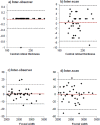Repeatability of Foveal Measurements Using Spectralis Optical Coherence Tomography Segmentation Software
- PMID: 26076457
- PMCID: PMC4468112
- DOI: 10.1371/journal.pone.0129005
Repeatability of Foveal Measurements Using Spectralis Optical Coherence Tomography Segmentation Software
Abstract
Purpose: To investigate repeatability and reproducibility of thickness of eight individual retinal layers at axial and lateral foveal locations, as well as foveal width, measured from Spectralis spectral domain optical coherence tomography (SD-OCT) scans using newly available retinal layer segmentation software.
Methods: High-resolution SD-OCT scans were acquired for 40 eyes of 40 young healthy volunteers. Two scans were obtained in a single visit for each participant. Using new Spectralis segmentation software, two investigators independently obtained thickness of each of eight individual retinal layers at 0°, 2° and 5° eccentricities nasal and temporal to foveal centre, as well as foveal width measurements. Bland-Altman Coefficient of Repeatability (CoR) was calculated for inter-investigator and inter-scan agreement of all retinal measurements. Spearman's ρ indicated correlation of manually located central retinal thickness (RT0) with automated minimum foveal thickness (MFT) measurements. In addition, we investigated nasal-temporal symmetry of individual retinal layer thickness within the foveal pit.
Results: Inter-scan CoR values ranged from 3.1 μm for axial retinal nerve fibre layer thickness to 15.0 μm for the ganglion cell layer at 5° eccentricity. Mean foveal width was 2550 μm ± 322 μm with a CoR of 13 μm for inter-investigator and 40 μm for inter-scan agreement. Correlation of RT0 and MFT was very good (ρ = 0.97, P < 0.0005). There were no significant differences in thickness of any individual retinal layers at 2° nasal compared to temporal to fovea (P > 0.05); however this symmetry could not be found at 5° eccentricity.
Conclusions: We demonstrate excellent repeatability and reproducibility of each of eight individual retinal layer thickness measurements within the fovea as well as foveal width using Spectralis SD-OCT segmentation software in a young, healthy cohort. Thickness of all individual retinal layers were symmetrical at 2°, but not at 5° eccentricity away from the fovea.
Conflict of interest statement
Figures




References
-
- Anger EM, Unterhuber A, Hermann B, Sattmann H, Schubert C, Morgan JE, et al. Ultrahigh resolution optical coherence tomography of the monkey fovea. Identification of retinal sublayers by correlation with semithin histology sections. Exp Eye Res. 2004;78(6):1117–25. - PubMed
MeSH terms
LinkOut - more resources
Full Text Sources
Other Literature Sources

